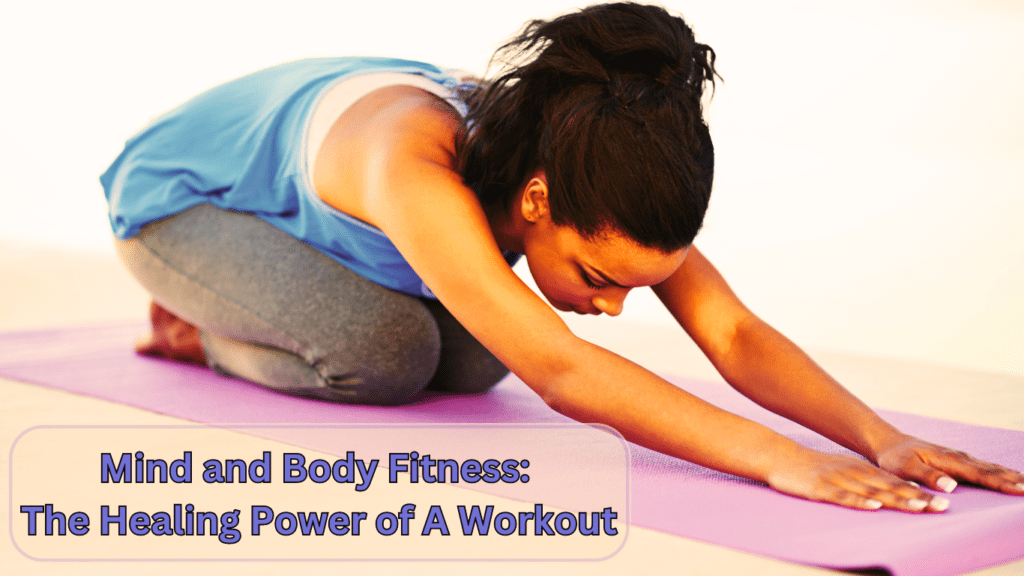Barre vs Pilates vs Yoga: Which One’s Right for You?
In this article, we will explore the key differences, benefits, and unique features of barre vs Pilates vs yoga, providing you with the insights needed to choose the best practice for your fitness journey and personal wellness goals.
Ever find yourself trying to pick between barre, Pilates, and yoga and feeling like you’re deciding between coffee, tea, and hot chocolate? They’re all great, they all have their benefits, but figuring out which one suits you best can feel like a major decision! Don’t worry—you’re not alone. A lot of people find themselves caught in the “barre vs Pilates vs yoga” debate, wondering which is right for their body and goals. In this article, we’ll break down the differences in a way that makes sense and help you make a choice based on your fitness needs.
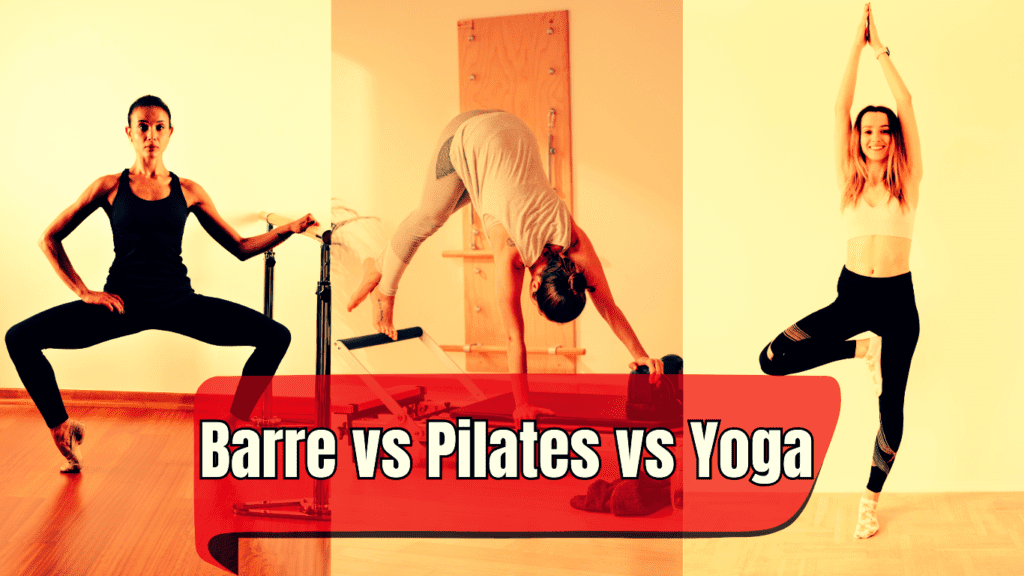
Purpose of the Article
This article aims to help you understand the unique aspects of barre, Pilates, and yoga. By the end of this read, you’ll have a clearer idea of how each workout targets different aspects of your fitness, allowing you to choose which one (or even a combination!) will work best for you. Whether you’re aiming for strength, flexibility, core stability, or a peaceful mind, the decision of “barre vs Pilates vs yoga” becomes easier when you have the right info. We’ll break down what each method offers, so you can match it with your personal fitness goals and lifestyle.
Why Compare Barre, Pilates, and Yoga?
It’s easy to see why people group barre, Pilates, and yoga together. They’re all incredibly popular and often share some similarities, like focusing on controlled movements and mind-body connection. But while they might all show up in your local fitness studio’s class schedule, they serve different purposes.
- Barre is a ballet-inspired workout, known for its low-impact, isometric movements. It often incorporates elements of dance, strength training, and flexibility. Many people are drawn to barre for the way it tones muscles, especially in the lower body, and its focus on small, repetitive movements that create a deep burn.
- Pilates is all about core strength, posture, and alignment. Originally developed by Joseph Pilates, this method is often done on a mat or using special equipment, like the Reformer. The goal here is balance and stability, with a focus on strengthening muscles without adding bulk.
- Yoga, on the other hand, comes from an ancient practice and is more than just a workout. While there are many different types of yoga, they all tend to focus on a mix of flexibility, breathwork, and mental clarity. Some forms of yoga are more intense (like power yoga or Ashtanga), while others, like Hatha or Yin Yoga, are slower and more restorative.
So why compare barre, Pilates, and yoga? Well, many people want a workout that helps them tone, stretch, and find balance, but it’s hard to know which one ticks the right boxes. These three methods often share overlapping benefits, yet each has its distinct focus. That’s where things can get a little confusing if you’re new to them. Do you go for a muscle-toning barre class, a core-strengthening Pilates session, or a flexibility-boosting yoga flow? That’s what we’re here to figure out.
Subscribe And Get Our Free E-Book:Unlocking The Power Of Nutrition-Supplements, Substitutes, and Superfoods!
Each of these workouts brings its own set of strengths, but they’re not one-size-fits-all. The decision often comes down to your fitness priorities and what kind of workout environment you enjoy. This comparison will help you weigh up the pros and cons, and discover which practice is the best fit for your needs.
Now, it’s important to note that there’s no wrong choice when it comes to deciding between barre, Pilates, and yoga. In fact, many people choose to combine all three in their routine. But understanding the key differences can help you streamline your decision and focus on what’s best for your body at this moment.
What’s the Reader’s Takeaway?
After reading this comparison of barre, Pilates, and yoga, you’ll walk away with a clearer understanding of each practice’s focus and benefits. Whether you’re new to these types of workouts or considering switching things up, this article will give you the tools to make an informed choice. You’ll learn:
- How barre can help sculpt and tone muscles with small, precise movements.
- Why Pilates is an excellent option for strengthening your core and improving your posture.
- What makes yoga the go-to for increasing flexibility and fostering a sense of calm and mindfulness.
Each discipline has its unique charm, and the right one for you will depend on what you’re hoping to achieve. Some might fall in love with the calming flow of a yoga class, while others may be drawn to the intense muscle burn of barre or the deep core focus of Pilates.
Choosing between barre, Pilates, and yoga doesn’t have to be stressful. Think of it as an opportunity to explore different workouts and see what makes you feel your best.
Barre vs Pilates vs Yoga: Overview of Each Discipline
Did you know that barre, Pilates, and yoga all share a focus on controlled, intentional movement but come from entirely different backgrounds? This makes choosing between them fascinating because, while they overlap in some benefits, each practice brings something unique to the table. Let’s break down each discipline to help you understand their origins, components, and who they’re best suited for, so you can make an informed choice in the “barre vs Pilates vs yoga” decision.
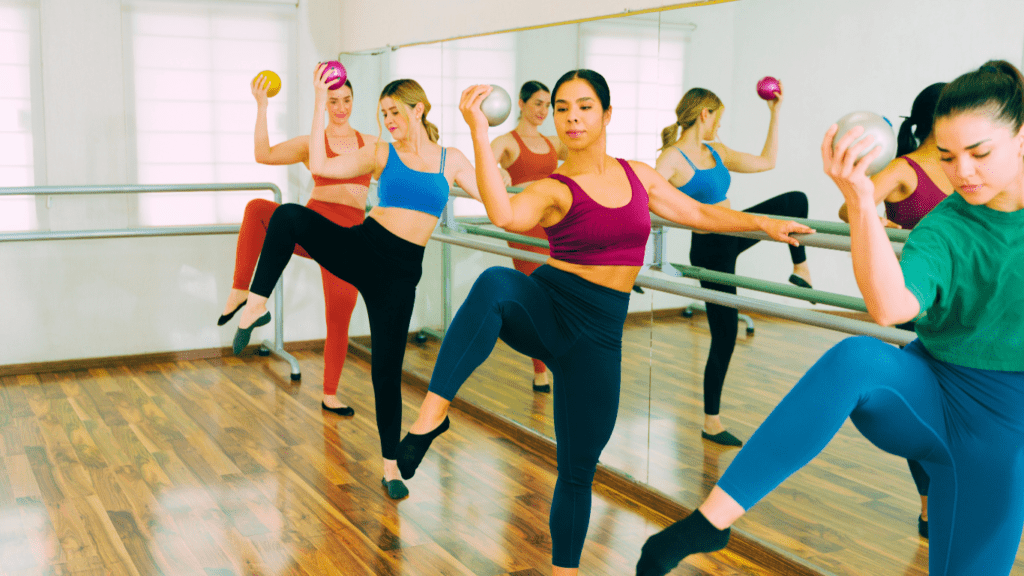
What is Barre?
Barre is a fusion workout that combines ballet-inspired movements with elements from Pilates, dance, yoga, and strength training. Unlike traditional ballet, you won’t be pirouetting across the room, but you will use a ballet barre for support as you perform small, precise, and repetitive movements. The focus here is on isometric contractions, meaning you’ll hold a position and engage your muscles for a prolonged period. Think of it like doing tiny, controlled movements that challenge your muscles in ways larger movements wouldn’t.
Barre originated in the late 1950s when Lotte Berk, a German ballerina, developed it as a way to rehabilitate her back while maintaining her fitness. It has since evolved, particularly in the U.S., where it’s become popular in boutique fitness studios for its ability to sculpt and tone the body.
At the core of barre is the use of a ballet barre for support. You’ll also use light weights (often 1-2 pounds), resistance bands, or exercise balls to add variety and challenge to the movements. Don’t be fooled by the small weights—barre is known for its high repetitions, which create a serious muscle burn, especially in your legs, glutes, and core.
So, who is barre best for? Barre is great for people looking to tone and tighten their muscles without adding bulk. It’s especially good for those who enjoy low-impact workouts that focus on balance, flexibility, and muscle endurance. If you like the idea of small, controlled movements that engage your muscles in a unique way, barre may be your go-to option in the “barre vs Pilates vs yoga” decision.
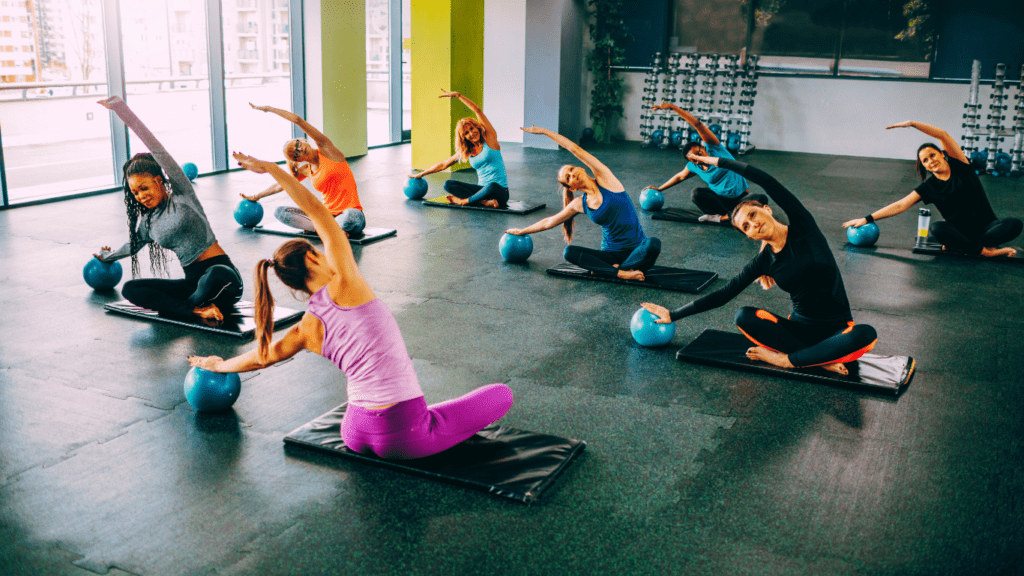
What is Pilates?
Pilates is a low-impact exercise method that emphasizes core strength, flexibility, and overall body alignment. It’s built around controlled, precise movements that engage deep stabilizing muscles, particularly in the core. Whether you’re doing mat Pilates or using the Reformer machine, the key is in how you move—slowly, intentionally, and with focused breathing.
The method was created by Joseph Pilates in the early 20th century, initially to help dancers and injured athletes recover and improve their performance. Today, Pilates has grown into a worldwide phenomenon, known for its ability to help with everything from posture correction to injury rehabilitation.
There are two main types of Pilates: mat Pilates and Reformer Pilates. Mat Pilates is done on the floor with minimal equipment, focusing on body weight exercises like planks, leg lifts, and spinal articulation. Reformer Pilates, on the other hand, uses a specialized machine with springs and pulleys to create resistance, which adds a different layer of challenge to the exercises. No matter which type you do, the emphasis is always on core stability, alignment, and controlled movements.
Who is Pilates best for? Pilates is ideal for anyone looking to improve their core strength, whether you’re a beginner or a more advanced fitness enthusiast. It’s also commonly recommended for people who are recovering from injuries, as it’s low-impact and focuses on alignment and muscle control. If your goal is to build a strong, stable core and improve your posture, Pilates may be the perfect choice for you when deciding between “barre vs Pilates vs yoga.”
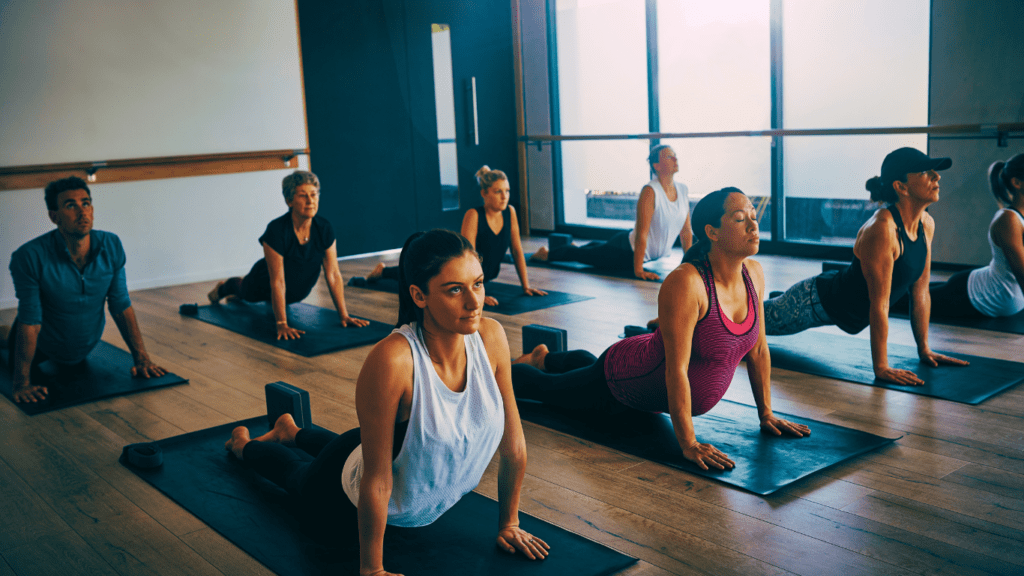
What is Yoga?
Yoga is a mind-body practice that combines physical postures (known as asanas), breathing techniques (pranayama), and meditation to promote both physical health and mental clarity. With roots that date back thousands of years to ancient India, yoga has evolved into various styles, but the common thread is its holistic approach to well-being.
There are many different styles of yoga to choose from, depending on what you’re looking for. Hatha yoga is great for beginners because it moves slowly and emphasizes proper form. Vinyasa yoga is more dynamic, with sequences that flow smoothly from one posture to the next, often coordinated with the breath. If you’re looking for a challenge, Ashtanga yoga offers a more rigorous, structured routine, while Yin yoga focuses on holding postures for longer periods to target deeper connective tissues and improve flexibility.
Yoga is unique in that it doesn’t just focus on physical fitness; it also encourages mindfulness and spiritual awareness. This makes it an excellent option for people who are not only looking to improve their flexibility and strength but also want to cultivate a sense of inner peace and stress relief.
Who is yoga best for? Yoga is ideal for anyone seeking a balance of physical and mental benefits. Whether you’re hoping to increase your flexibility, reduce stress, or improve your overall mind-body connection, yoga offers a wide range of styles to fit your needs. For those who prioritize mental clarity and stress management, yoga is often the best option in the “barre vs Pilates vs yoga” comparison.
Understanding the basics of each discipline can help guide your decision in the ongoing “barre vs Pilates vs yoga” debate. Barre is best for those looking to tone and strengthen with ballet-inspired, isometric movements. Pilates is perfect for improving core strength, posture, and stability through controlled, precise exercises. Yoga offers a holistic approach to both physical fitness and mental well-being, with various styles to suit different needs. Each practice has something unique to offer, and the right one for you depends on your fitness goals and personal preferences.
Barre vs Pilates vs Yoga: Quick Comparison Chart
| Aspect | Barre | Pilates | Yoga |
|---|---|---|---|
| Main Focus | Muscle toning, flexibility, balance | Core strength, posture, stability | Flexibility, breathwork, mindfulness |
| Primary Muscles Targeted | Lower body (legs, glutes), core | Core, back, stabilizing muscles | Full body (with emphasis on flexibility) |
| Intensity | Moderate to high (burn in muscles) | Moderate (focus on control and form) | Varies (depends on style – from gentle to intense) |
| Equipment Used | Ballet barre, light weights, resistance bands | Mat or Reformer machine | Typically no equipment (blocks, straps may be used) |
| Impact Level | Low-impact | Low-impact | Low-impact (but varies by style) |
| Origins | Ballet-inspired, developed by Lotte Berk | Developed by Joseph Pilates for rehab | Ancient Indian practice, spiritual roots |
| Best For | Toning muscles without bulk, balance, endurance | Core stability, improving posture, injury recovery | Flexibility, stress relief, mindfulness |
| Mental Benefits | Focus on endurance and controlled movements | Focus on breath and alignment | High emphasis on mental clarity, relaxation, and meditation |
| Popular Styles/Classes | Ballet Barre, Cardio Barre | Mat Pilates, Reformer Pilates | Vinyasa, Hatha, Ashtanga, Yin, Restorative |
| Ideal For | People looking to sculpt, tone, and build endurance | Those seeking core strength, rehab, or posture improvement | Anyone seeking both physical and mental well-being |
Additional Key Takeaways
- Barre focuses heavily on small, controlled movements that challenge muscles through high repetitions, especially for the lower body. It’s great for those who want to feel the burn and enhance muscle tone.
- Pilates works wonders for building core strength and improving posture, with a focus on stability. It’s ideal for injury recovery and for anyone looking to develop a strong foundation.
- Yoga offers a comprehensive approach to fitness, focusing on flexibility, stress relief, and mind-body connection. It’s perfect for those looking to improve their physical health while calming their mind.
Barre vs Yoga vs Pilates Video
Benefits and Focus Areas
When it comes to choosing between barre, Pilates, and yoga, understanding the specific benefits each offers can make the decision easier. While they all emphasize different aspects of fitness, they also overlap in ways that might appeal to your personal goals. Whether you’re looking to build strength, improve flexibility, shed some pounds, or find a sense of calm, each discipline offers its unique strengths. Let’s break down the benefits and focus areas of each in the “barre vs Pilates vs yoga” comparison.
Strength Building: Barre vs Pilates vs Yoga
When it comes to strength building, each of these workouts approaches it differently, focusing on various parts of the body and using distinct methods.
Barre is known for its focus on muscle endurance and toning, especially in the lower body. The exercises often target the legs, glutes, and core through small, controlled movements. With high repetitions and the use of light weights or resistance bands, barre classes are designed to fatigue specific muscle groups and create that “burn” many participants seek. You may not lift heavy weights in barre, but you’ll definitely feel the muscles working—especially in your thighs, calves, and glutes.
Pilates, on the other hand, emphasizes core strength. It’s known for its ability to improve stability, posture, and overall alignment through exercises that target the deep abdominal muscles. While Pilates primarily focuses on the core, it also engages the upper and lower body, particularly in Reformer Pilates, which uses equipment to add resistance. Pilates is ideal for those wanting to build a strong, stable core without bulking up.
Yoga builds strength through bodyweight exercises, with a focus that varies depending on the style. In more dynamic practices like Power Yoga or Ashtanga, you’ll engage in planks, chaturangas, and various balancing poses that require upper body, core, and leg strength. Although yoga doesn’t typically use weights or resistance bands, holding certain poses like Warrior II or Chair Pose for extended periods challenges the muscles in a different way.
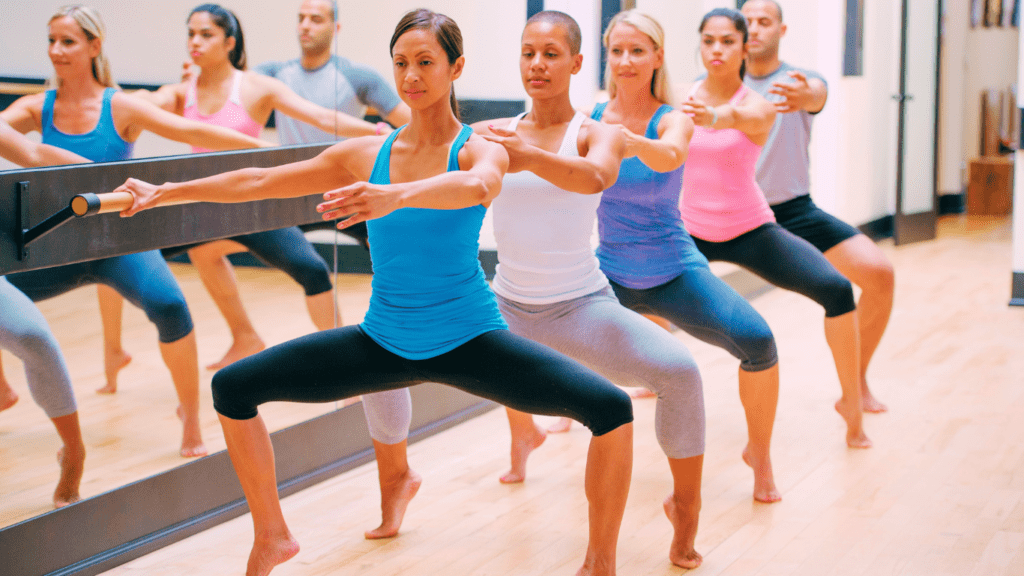
Flexibility and Mobility: Barre vs Pilates vs Yoga
Flexibility is an important aspect of fitness, and each practice in the barre vs Pilates vs yoga comparison offers a unique approach to improving it.
Barre incorporates some flexibility work, particularly through controlled stretching and ballet-inspired movements that improve range of motion in the legs and hips. However, flexibility isn’t the primary focus of barre—rather, it’s a secondary benefit that comes from the repetitive, low-impact movements. You’ll likely notice improvements in how your muscles stretch and lengthen over time, but the class doesn’t revolve around deep flexibility training.
Pilates, while also improving flexibility, is more about controlled movement and core stability. The focus here is on ensuring proper alignment while gently increasing range of motion. In Pilates, you won’t necessarily push your body into extreme flexibility, but the exercises promote functional flexibility that improves overall mobility in a safe and supportive way.
Yoga, however, places a significant emphasis on flexibility and joint mobility. Many styles, particularly Hatha and Yin yoga, are centered around stretching and opening up the body. With postures that target the hamstrings, hips, and spine, yoga can help you achieve greater flexibility than either barre or Pilates. Additionally, practices like Yin yoga focus on holding poses for longer durations, which allows for deeper stretches and improves joint health over time.
Cardio and Fat Loss: Barre vs Pilates vs Yoga
If your goal is cardiovascular health or fat loss, knowing how each of these disciplines stacks up in this area can help guide your decision.
Barre offers a moderate calorie burn, and some classes include small bursts of cardio to elevate the heart rate. While barre isn’t as intense as running or a traditional cardio workout, the high-repetition, low-impact movements combined with light cardio can contribute to fat loss over time, especially if paired with a healthy diet.
Pilates is less focused on cardio, with the main benefits coming from toning and muscle control. While a Pilates class can be challenging and will improve muscle definition, it typically won’t raise your heart rate enough for significant fat loss. That said, many people find that Pilates helps reshape their body by building lean muscle, which can contribute to overall weight management.
Yoga’s impact on cardio and fat loss depends largely on the style. Vinyasa or Power Yoga can provide a cardiovascular challenge, with sequences that flow quickly from one pose to the next. These more intense styles may help burn calories and contribute to weight loss. In contrast, Hatha or Restorative Yoga focuses on slower, meditative movements, and while they have numerous benefits, fat burning isn’t a primary outcome in these sessions.
Mind-Body Connection: Barre vs Pilates vs Yoga
The mind-body connection is another key area where these disciplines differ, and it can be a deciding factor in the “barre vs Pilates vs yoga” debate depending on what you’re looking for in your fitness routine.
Barre, while requiring concentration and precision, doesn’t typically emphasize the mind-body awareness that you find in Pilates or yoga. You’ll need to focus on your form and alignment, but the mental component is often secondary to the physical workout itself.
Pilates, however, places a strong emphasis on the connection between breath, movement, and mental focus. Pilates practitioners often talk about the importance of breath control and maintaining awareness of the body’s alignment throughout the exercises. This mental focus not only helps improve form but also creates a deeper sense of body awareness.
Yoga, of course, is deeply rooted in the mind-body connection. It’s not just about moving through the poses but also about connecting your breath to each movement and finding mental clarity in the process. Whether through pranayama (breathing techniques) or the meditative aspects of the practice, yoga encourages a deeper sense of self-awareness and mindfulness, making it an excellent option for those seeking both physical and mental balance.
Each discipline in the barre vs Pilates vs yoga comparison offers distinct benefits depending on your fitness goals. Whether you’re looking to build strength, improve flexibility, boost cardiovascular health, or cultivate a deeper mind-body connection, understanding the unique focus of each practice can help you choose the one that best suits your needs.
Barre vs Pilates vs Yoga: Considerations for Choosing the Right Practice
Trying to pick between barre, Pilates, and yoga can feel a bit like choosing what to have for breakfast—each option has its own benefits, but it really depends on what you’re in the mood for. And just like breakfast, your choice in fitness routine can set the tone for the rest of your day (or week!). Here’s an interesting fact: Research shows that sticking to a fitness routine you enjoy increases your chances of long-term success. So, let’s dive into the key considerations to help you decide which of these popular practices might be your best fit.
Fitness Goals
Your fitness goals play a major role in deciding whether barre, Pilates, or yoga is the right path for you. Here’s how each stacks up based on common goals:
If your goal is to lose weight and burn fat, the right choice in the barre vs Pilates vs yoga debate depends on the intensity you’re looking for. Barre tends to offer moderate calorie burning, especially in classes that incorporate light cardio bursts along with high-rep, low-weight movements. You may not leave drenched in sweat, but the combination of strength and movement does help with fat loss over time. Pilates is less cardio-focused and more about toning and control, so while it builds lean muscle, it may not be as effective for calorie-burning compared to other options. Yoga’s ability to burn calories varies depending on the style—Vinyasa or Power Yoga can certainly get your heart rate up, while slower styles like Hatha focus more on flexibility and relaxation.
If your goal is to tone muscles and increase strength, barre shines for those seeking muscle endurance and definition, especially in the lower body (legs, glutes) and core. Pilates, particularly Reformer Pilates, is excellent for building core strength and improving muscle tone without adding bulk. While yoga offers strength-building benefits, particularly in more intense practices like Ashtanga or Power Yoga, it’s less targeted for specific muscle toning compared to barre and Pilates.
If you’re focused on improving posture or recovering from an injury, Pilates and yoga are both fantastic options. Pilates, with its focus on alignment and core stability, is often recommended for rehabilitation and can help with posture correction and injury recovery. Yoga, especially gentle styles like Hatha or Restorative Yoga, also supports recovery through mobility and stretching, while promoting mental relaxation, which can aid the healing process.

Fitness Level
Your current fitness level is another key consideration when choosing between barre, Pilates, and yoga.
For beginners, yoga tends to be the most approachable. Many styles, such as Hatha yoga, focus on slow, gentle movements and can be easily adapted for those with no prior experience. Barre is also beginner-friendly, though the small, precise movements may take a bit of getting used to. The moves are simple but challenging in the way they engage specific muscle groups. Mat Pilates is also accessible to beginners, but it requires a higher level of body awareness and core control compared to the other two.
For those seeking an advanced practice, both Pilates and yoga offer greater opportunities for progression. Reformer Pilates can be particularly challenging, with the springs adding extra resistance and variety. Advanced yoga styles, like Ashtanga or Power Yoga, are also quite demanding, both physically and mentally, requiring balance, flexibility, and strength. Barre offers progression as well, with the option to increase repetitions and resistance, but it’s generally not as intense as advanced Pilates or yoga.
Time Commitment and Convenience
When it comes to how much time you have and the convenience of fitting these practices into your life, you’ll want to consider the time commitment and where you plan to practice.
The average duration of a barre, Pilates, or yoga class is about 45 minutes to an hour. Some yoga and Pilates classes may run a bit longer, especially if they include extended breathing exercises or meditation in the case of yoga.
If you’re considering the at-home vs in-class option, yoga is easily the most convenient to practice at home. All you need is a yoga mat and a little open space. You can find a wealth of online classes, and with so many different styles available, you can switch things up without leaving your living room. Mat Pilates is also feasible at home with minimal equipment, but for more advanced Pilates practices, such as Reformer Pilates, you’d need specialized equipment that is typically found in a studio. Barre can also be done at home with a sturdy piece of furniture (like a countertop) as your barre and light weights or resistance bands, though it’s often easier to follow along in a class setting where the instructor can guide you through the intricate movements.
Equipment and Space Requirements
Finally, it’s important to think about the equipment and space needed for each of these practices.
For barre, you’ll need access to a ballet barre (or a makeshift one, like a chair or countertop), light weights, and space to move. Some barre classes also incorporate exercise balls and resistance bands to intensify the workout, so having those on hand could be helpful if you’re practicing at home.
Pilates is a bit more varied in terms of equipment. Mat Pilates requires just a Pilates mat, which is often a bit thicker than a standard yoga mat. You might also use Pilates balls, resistance bands, or small hand weights to add resistance to your routine. Reformer Pilates requires a Reformer machine, which is quite specialized and typically found in studios, making it harder to practice effectively at home unless you invest in your own equipment.
Yoga is the simplest in terms of equipment—you really only need a yoga mat, and optionally, yoga blocks or a strap to help with certain stretches. The practice can be done almost anywhere, making it highly convenient for those with limited space.
Chart: Barre vs Pilates vs Yoga – A Comparison Guide
| Fitness Goal | Barre | Pilates | Yoga |
|---|---|---|---|
| Strength Building | Focus on muscle endurance and toning, especially lower body (legs, glutes, core). High-rep, low-weight movements. | Focus on core strength and overall stability. Improves posture and alignment, with a focus on deep abdominal muscles. | Builds strength through bodyweight exercises. More dynamic styles (Power, Ashtanga) offer upper body, core, and leg strength. |
| Flexibility & Mobility | Improves range of motion, especially in the hips and legs, but flexibility is a secondary benefit. | Enhances functional flexibility with a focus on alignment and mobility. | Significant emphasis on flexibility and joint mobility, especially in styles like Hatha, Yin, and Vinyasa. |
| Cardio & Fat Loss | Moderate calorie burn, with light cardio bursts for fat loss. Great for toning and endurance. | Less focused on cardio; helps reshape body by building lean muscle. | Vinyasa or Power Yoga offer cardiovascular benefits, while Hatha or Restorative Yoga focus on relaxation. |
| Mind-Body Connection | Requires concentration and precision but doesn’t emphasize deep mental focus. | Strong focus on breath control, mental focus, and body awareness. | Deep mind-body connection, integrating breath with movement, mindfulness, and meditation. |
| Posture & Alignment | Helps with overall body toning, but less focused on posture correction. | Strong focus on improving posture and alignment, ideal for injury rehabilitation. | Emphasizes alignment, particularly in restorative or gentle practices like Hatha. |
| Injury Recovery & Rehabilitation | Low-impact, great for toning and flexibility, but not specific for rehabilitation. | Ideal for improving posture and muscle control during recovery, especially core. | Gentle styles (Hatha, Restorative) can support recovery through stretching and relaxation. |
| Fitness Level | Accessible to beginners, but precise movements may take time to master. | Beginner-friendly with a focus on core control, but requires body awareness. | Beginner-friendly, especially Hatha. Advanced forms (Ashtanga) offer greater challenges. |
| Class Duration & Time Commitment | 45-60 minutes, typically with more repetitions and less rest. | 45-60 minutes, with focus on controlled, slower movements. | 45-90 minutes, depending on style; includes breathing and meditation. |
| Equipment & Space | Requires ballet barre (or substitute), light weights, and optional resistance bands. | Pilates mat, optional small equipment (bands, balls, weights), or Reformer machine for more advanced practice. | Only requires a yoga mat; optional blocks, straps for deeper stretches. |
| Home Practice Feasibility | Can be done at home with a sturdy surface, light weights, and resistance bands. | Can be practiced at home with minimal equipment (mat, bands, weights); Reformer requires studio. | Very easy to practice at home, especially with online classes. |
Key Takeaways:
- Barre is great for those seeking muscle toning, especially in the lower body, and muscle endurance without bulk. It’s a solid choice if you enjoy a low-impact, controlled movement workout.
- Pilates excels at strengthening the core and improving posture. It’s ideal for those focused on stability, alignment, and injury recovery.
- Yoga offers a holistic approach, balancing physical strength with mental clarity and flexibility. It’s a great choice if you’re looking for a mind-body connection and flexibility improvement.
In the final decision of barre vs Pilates vs yoga, it all comes down to your specific fitness goals, current fitness level, and practical considerations like time and space. If you’re looking for muscle toning, especially in the lower body, with a focus on small, controlled movements, barre is an excellent choice. Pilates offers a stronger focus on core strength and rehabilitation, making it perfect for those recovering from injuries or wanting to improve posture. Yoga provides a holistic approach to both physical fitness and mental well-being, with a strong emphasis on flexibility and the mind-body connection. Ultimately, whichever path you choose, you’re sure to gain both physical and mental benefits from these popular disciplines.
Pros and Cons
Choosing between barre, Pilates, and yoga is a bit like trying to decide between binge-watching your favorite series, getting some exercise, or starting a new hobby—you know all are good for you, but only one feels right at a time! In this part of the article, we’ll explore the pros and cons of each practice, so you can easily weigh your options and decide which is the best fit for you.
Pros and Cons of Barre
Pros of Barre:
- Fun, fast-paced classes: Barre classes tend to be high-energy and engaging, keeping you on your toes (literally) throughout the workout.
- Focus on muscle toning and endurance: Particularly effective for building lower body strength—especially in the legs, glutes, and thighs.
- Low-impact: Great for those who want an effective workout without putting too much strain on their joints.
Cons of Barre:
- Less focus on flexibility: Unlike yoga, barre doesn’t emphasize stretching or improving joint mobility as much.
- Limited mind-body connection: It’s a muscle-focused workout, so if you’re looking for mental or spiritual engagement, you may find it lacking.
- Challenging for beginners: Without a background in dance or coordination, barre’s ballet-inspired movements can be difficult to master at first.
Pros and Cons of Pilates
Pros of Pilates:
- Core-centric workout: Pilates is highly focused on building core strength, which is great for posture and overall body stability.
- Great for injury recovery: Pilates is commonly used for rehabilitation, as it emphasizes controlled movements and alignment, which can aid in recovery from injuries, especially back pain.
- Adaptable for all fitness levels: Exercises can be modified to fit beginners as well as advanced practitioners, making it an accessible practice for everyone.
Cons of Pilates:
- Lower cardio intensity: Pilates doesn’t typically get your heart rate up, so it’s not the best option if you’re aiming for high-calorie burns.
- Requires precise form: Poor technique can lead to injury, especially for beginners. It’s recommended to start with a certified instructor to learn proper form.
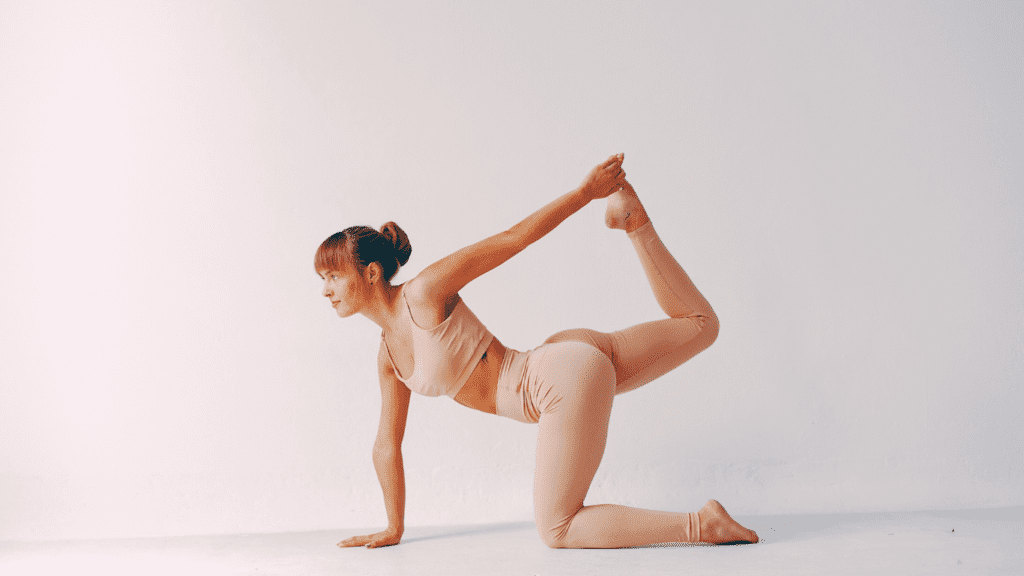
Pros and Cons of Yoga
Pros of Yoga:
- Holistic approach: Yoga integrates mind, body, and breath, offering both physical benefits and mental relaxation.
- Excellent for flexibility: Regular yoga practice can significantly improve your joint mobility and muscle flexibility, especially with styles like Yin Yoga or Hatha Yoga.
- Mindfulness and relaxation: Yoga helps to reduce stress and improve mental clarity through techniques like meditation and breathwork.
Cons of Yoga:
- Limited strength-building: While yoga does incorporate some bodyweight exercises (e.g., planks, chaturanga), it may not provide enough muscle-toning for some people.
- Certain styles can feel slow-paced: If you’re seeking an energetic workout, practices like Restorative Yoga or Hatha might feel too slow and relaxed for your liking.
Making Your Choice
When comparing barre vs Pilates vs yoga, it’s clear that each practice offers its own unique benefits:
- Barre: Great for toning and lower body endurance, but it doesn’t emphasize flexibility or mind-body awareness.
- Pilates: Excellent for core strength, posture, and injury recovery, though less effective for cardio.
- Yoga: Best for flexibility, mindfulness, and relaxation, though not always ideal for those focused on building strength or toning muscles.
In the end, the decision comes down to your fitness goals and personal preferences. Whether you opt for the high-energy tone of barre, the core stability focus of Pilates, or the holistic approach of yoga, you’re making a great choice for your overall wellness.
Practical Advice on Choosing Between Barre vs Pilates vs Yoga
Choosing between barre, Pilates, and yoga can feel like trying to pick the perfect coffee order—you’ve got options, and they all seem to hit the spot, but each one offers something a little different. In this section, we’ll dive into some practical advice to help you make the right choice based on your fitness goals, lifestyle, and preferences. By the end of this, you’ll have a clear sense of how to select the workout that suits you best or whether mixing all three might be the key to your fitness success.
Barre vs Pilates vs Yoga: Goal-Oriented Selection
When deciding between barre vs Pilates vs yoga, your fitness goals are going to play a big role in your choice. Each discipline focuses on different aspects of fitness, so it’s important to match your goals to the right practice.
- Weight Loss and Cardio: If your main focus is weight loss or burning calories, you might find barre to be a good option. While it’s not as cardio-heavy as running or cycling, the fast pace of many barre classes, along with the incorporation of small bursts of cardio, can help raise your heart rate and contribute to fat loss. Certain styles of yoga, such as Vinyasa or Power Yoga, also incorporate more dynamic movements and can provide a similar calorie burn, but these will still be less intense than a barre session.
- Muscle Toning and Strength: If you’re focused on toning and building muscle endurance, barre is excellent, especially for the lower body. The targeted, small, repetitive movements in barre work wonders for toning muscles, particularly in the legs and glutes. For core strength, however, Pilates is the clear winner. The practice is built around developing deep core muscles and improving posture. On the other hand, yoga, while great for strength-building in certain styles (like Ashtanga or Vinyasa), tends to be more holistic and doesn’t offer the same focused muscle toning that barre or Pilates can provide.
- Flexibility and Mobility: If flexibility and joint mobility are top priorities, yoga is your best bet. Yoga practices like Hatha, Yin, and Restorative focus heavily on stretching and improving the range of motion in the body. Pilates also helps with flexibility, but its primary focus is on control and stability rather than the deep stretches you find in yoga. Barre, while helping with some mobility, doesn’t prioritize flexibility as much.
- Stress Reduction and Mindfulness: If you’re looking for stress relief or something that helps you disconnect from the chaos of life, yoga offers a strong mind-body connection through breathwork and sometimes meditation. Practices like Restorative Yoga and Yin Yoga are designed specifically to calm the nervous system. Pilates also focuses on mental concentration and breath control, but yoga goes a step further with its deeper emphasis on mindfulness. Barre, on the other hand, is more physically focused and doesn’t typically prioritize mental relaxation.
Barre vs Pilates vs Yoga: Try Before You Commit
Sometimes, the best way to figure out what works for you is to sample each discipline. Rather than committing to one before you’re sure, try attending a class in each of the three: barre, Pilates, and yoga. Many gyms or studios offer trial classes or even online platforms that allow you to experiment with different styles from the comfort of your home.
- Barre Classes: If you enjoy fast-paced, dynamic workouts with a focus on muscle toning, a barre class might feel energizing and motivating for you.
- Pilates Classes: If you prefer a slower, more controlled workout that really challenges your core strength, Pilates will likely resonate with you.
- Yoga Classes: If flexibility, stress relief, or mind-body connection is a priority, attending a yoga class will give you insight into whether this practice is the right fit.
By trying all three, you can better understand how each one makes you feel both physically and mentally.
Mixing It Up
One option that you shouldn’t overlook is the idea of combining barre, Pilates, and yoga into your fitness routine. Each practice offers unique benefits, and together, they can create a balanced workout plan that addresses various fitness needs.
- Barre provides a great toning workout for the lower body.
- Pilates focuses on strengthening your core and improving posture.
- Yoga can help improve flexibility, balance, and mental relaxation.
By incorporating all three into your routine, you ensure that you’re working different areas of your body while also balancing strength with flexibility and mindfulness. For example, you could do barre a couple of times a week for toning, add a Pilates session to focus on your core, and finish the week with yoga to stretch and relax your body.
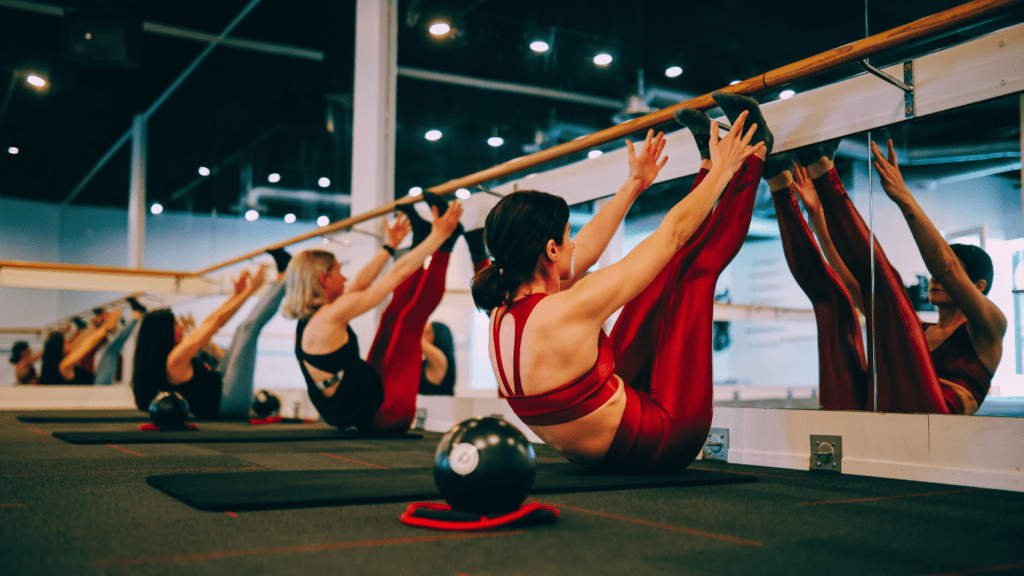
When Choosing Between Barre vs Pilates vs YogaConsider Lifestyle Factors
Beyond your fitness goals, there are lifestyle factors that may influence your decision between barre vs Pilates vs yoga. It’s essential to consider what fits best with your daily schedule, availability of classes, and personal preferences in terms of exercise style.
- Availability of Classes: Are barre, Pilates, and yoga classes easily accessible in your area? Yoga is widely available both in studios and online, while barre and Pilates may be more specialized and require finding a specific studio or gym.
- Time Commitment: How much time can you dedicate to your workouts? Barre and Pilates classes tend to run around 45 minutes to an hour, similar to most yoga classes. However, Pilates (especially with equipment like the reformer) may require more instruction, while yoga and barre can often be done at home with minimal equipment.
- At-Home Convenience: All three can be done at home, but they differ in terms of equipment. Yoga typically requires just a mat, while Pilates may need additional props like a Pilates ring or resistance bands. Barre workouts often require a stable surface (like a chair or a wall) to serve as a makeshift barre, along with light weights or resistance bands.
- Personal Preferences: Lastly, think about what you enjoy. Do you prefer slow, mindful movements? Or do you thrive in a more energetic, upbeat environment? Your preference for exercise style will greatly influence which of the three you enjoy most and are more likely to stick with long term.
When faced with the choice of barre vs Pilates vs yoga, the decision comes down to what aligns with your fitness goals and lifestyle. Whether you’re aiming to lose weight, build strength, improve flexibility, or simply reduce stress, each practice has something valuable to offer. By trying them out, mixing them together, or considering how they fit into your daily life, you’ll be able to make the right choice that keeps you motivated and engaged in your fitness journey.
Final Thoughts on Barre vs Pilates vs Yoga: Finding Your Best Fit
When it comes to choosing between barre, Pilates, and yoga, it can sometimes feel like being a kid in a candy store—there are so many enticing options! Each of these fitness disciplines has its unique offerings, benefits, and focus areas. In this final part, we’ll summarize the key differences and highlights of barre vs Pilates vs yoga, encouraging you to evaluate your personal needs and inspiring you to explore these practices.
Key Differences and Highlights
- Barre:
- Focus: Primarily on muscle toning, particularly in the lower body.
- Benefits: Improves endurance, balance, and posture while providing a fun, energetic workout environment.
- Components: Combines elements of ballet, Pilates, and yoga, using a ballet barre and small weights for high-repetition exercises.
- Best For: Those looking for a workout that emphasizes strength and toning, especially for the legs and glutes.
- Pilates:
- Focus: Concentrates on core strength, stability, and body alignment.
- Benefits: Excellent for rehabilitation, improving posture, and enhancing flexibility while maintaining control in movements.
- Components: Can be practiced on a mat or with specialized equipment like a reformer, focusing on precision and controlled breathing.
- Best For: Individuals looking to strengthen their core, improve posture, and those in need of rehabilitation exercises.
- Yoga:
- Focus: Integrates mind-body connection, flexibility, and mindfulness.
- Benefits: Promotes stress relief, relaxation, and holistic health while enhancing flexibility and strength through various postures (asanas).
- Components: Involves different styles ranging from gentle restorative practices to more vigorous styles like Vinyasa and Ashtanga.
- Best For: Anyone seeking a workout that promotes mental clarity, stress reduction, and overall well-being.
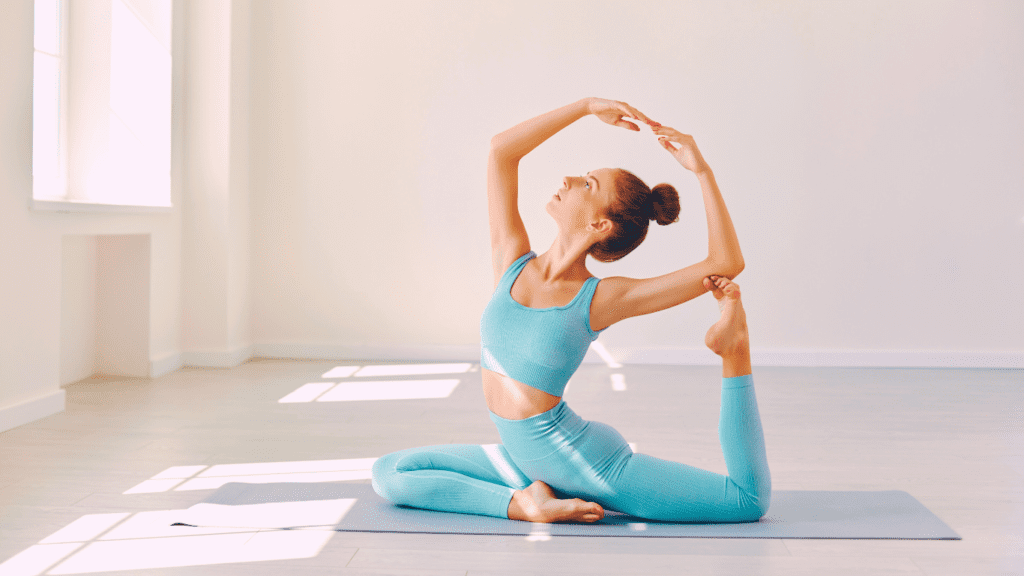
Evaluating Your Personal Needs
As you navigate your fitness journey, it’s essential to reflect on your personal goals and preferences. Do you want to tone your body, improve your core strength, or find a way to de-stress? The best approach is to try each discipline and see which resonates with you the most.
Incorporating elements from all three practices can provide a well-rounded fitness routine, ensuring you’re working on strength, flexibility, and mindfulness. The key is to stay open to exploring and discovering what truly aligns with your needs.
Frequently Asked Questions (FAQs)
- What is the primary difference between barre, Pilates, and yoga?
- Answer: Barre focuses on muscle toning and endurance, Pilates emphasizes core strength and stability, while yoga integrates physical postures with mindfulness and stress relief.
- Can I lose weight with barre, Pilates, or yoga?
- Answer: Yes, barre can contribute to weight loss through its calorie-burning, toning workouts. Yoga can help manage stress, which is beneficial for weight control. Pilates helps build muscle, which can also aid in weight management.
- Which practice is best for beginners?
- Answer: Yoga often offers various classes designed for beginners, but all three disciplines have options that cater to new practitioners. It’s advisable to start with introductory classes for any of them.
- How often should I practice barre, Pilates, or yoga?
- Answer: For best results, aim for 2-3 sessions per week of your chosen practice. However, mixing practices can enhance your overall fitness and keep your routine fresh.
- Do I need special equipment for barre or Pilates?
- Answer: Yes, barre classes typically require a barre and light weights, while Pilates may need a mat and possibly a reformer or other props. Yoga primarily requires a mat.
- Are barre, Pilates, and yoga suitable for all fitness levels?
- Answer: Yes, each practice can be adapted to different fitness levels. Always inform your instructor of your fitness level so they can provide appropriate modifications.
- What should I wear to a barre, Pilates, or yoga class?
- Answer: Wear comfortable, stretchy clothing that allows for movement. Many prefer to practice barefoot, especially in barre and Pilates, while yoga practitioners often wear sticky socks if desired.
- Can I practice yoga if I have injuries?
- Answer: Yes, yoga can be beneficial for injury rehabilitation. However, it’s crucial to consult with a healthcare professional or a certified instructor to ensure you’re choosing appropriate poses.
- What type of yoga is best for stress relief?
- Answer: Restorative, Yin, and Hatha yoga styles are particularly effective for stress relief, as they emphasize gentle movements and deep relaxation.
- Is it necessary to attend classes, or can I practice at home?
- Answer: Both options are valid! Many find attending classes helpful for guidance and motivation, but numerous online resources allow for effective at-home practice in all three disciplines.
Ultimately, the choice between barre, Pilates, and yoga boils down to what you enjoy and what aligns best with your fitness goals. Each practice offers distinct benefits that cater to various needs, whether you seek strength, flexibility, or mental clarity. By taking the time to evaluate your personal goals and trying each method, you can embark on a fulfilling and enjoyable fitness journey tailored just for you. Remember, your body and mind will thank you for the effort you put into finding the right fit!


